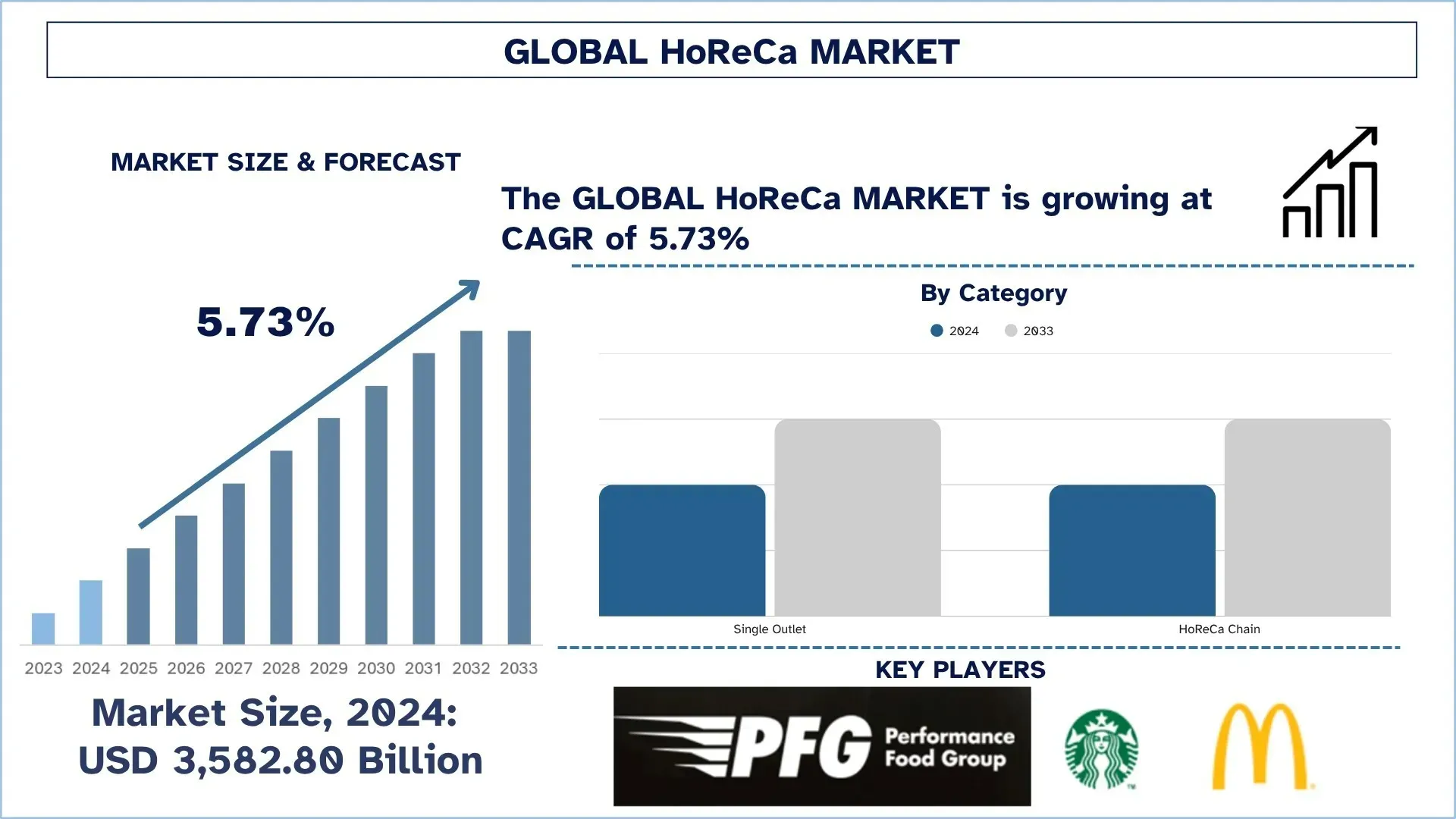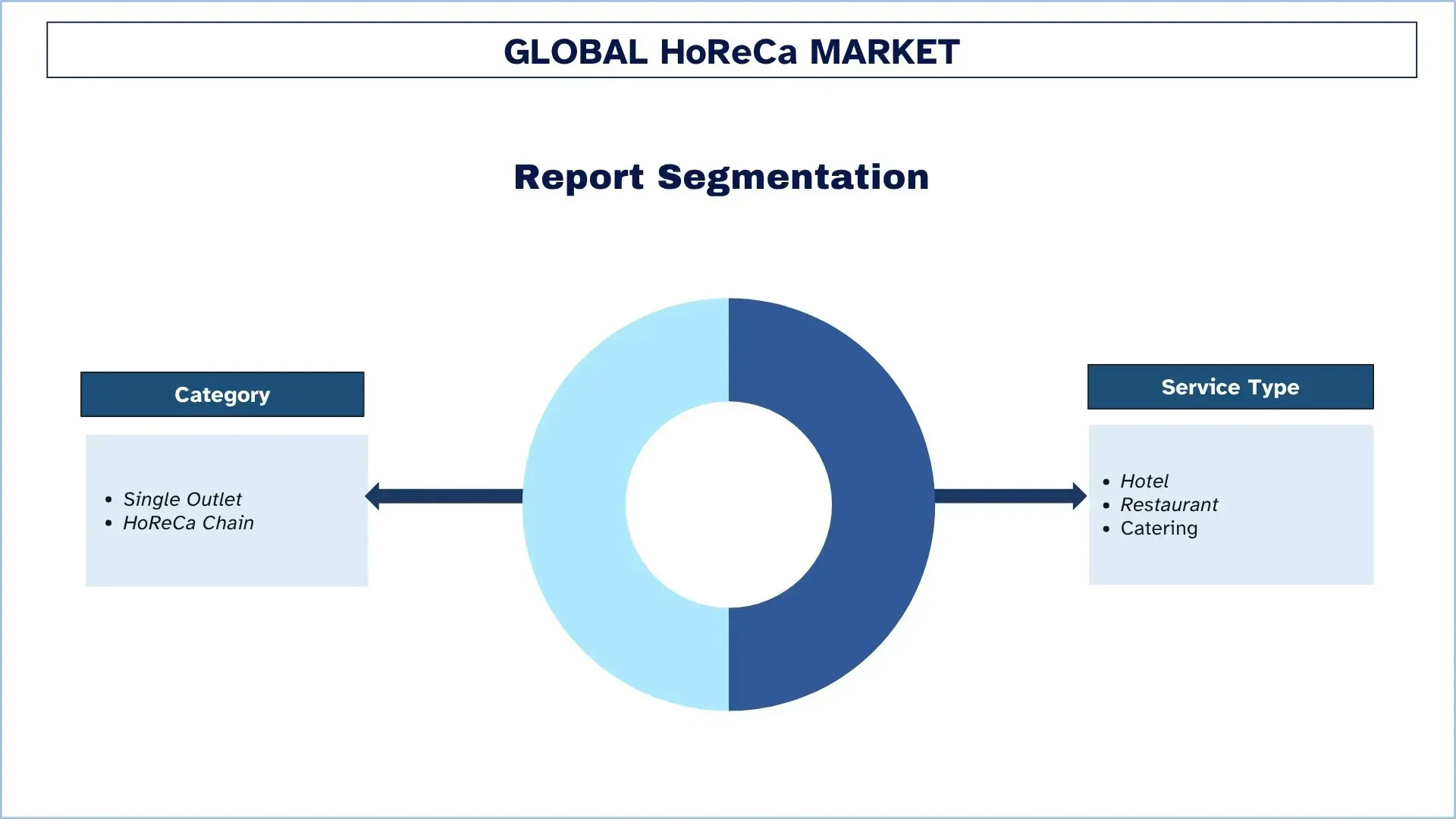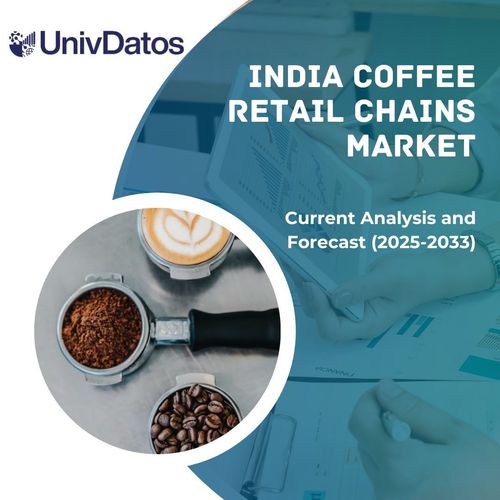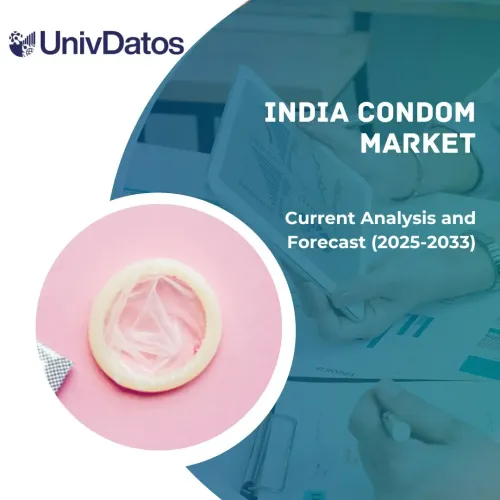- Home
- About Us
- Industry
- Services
- Reading
- Contact Us
HoReCa Market: Current Analysis and Forecast (2025-2033)
Emphasis on Category (Single Outlet and HoReCa Chain); Service Type (Hotels, Restaurants, Catering); and Region/Country

Global HoReCa Market Size & Forecast
The Global HoReCa Market was valued at USD 3,582.80 million in 2024 and is expected to grow at a steady CAGR of around 5.73% during the forecast period (2025-2033F), due to expanding middle-class wallets and dense urban lifestyles accelerate eating-out frequency, demand for diverse cuisines, convenience formats, and experiential dining, pushing operators to scale innovative concepts and preimmunize menus for customers.
HoReCa Market Analysis
The HoReCa (Hotel, Restaurant, and Catering) market is set to experience greater growth, fueled by changing consumer behavior, technological changes, and growth in travel and dining post-pandemic. The industry is in a bounce-back period, with consumers focusing more on convenience, dining experience, and digital interaction. On the other hand, demand for high-end foodservice experiences is getting a big boost due to rising income in emerging economies, growing urbanization, and, again, global tourism. Additionally, technology plays the chief role while scaling up this industry. Digitization of order-taking, AI-based personalization, and delivery services are settling in well in operation and elevating the customer experience to another level. The combination of healthy and sustainability trends in the dining sector, however, inspires the operator to provide innovation while opening the doors to plant-based choices with ethically sourced ingredients on the menu. For instance, in 2025, according to the data published by THP (Top Hotel Projects), one of the global companies that deals with a hotel projects database, connecting suppliers with decision-makers in the hotel industry, stated that there are currently 8011 hotel opening projects in the pipeline globally, with 2,771 (35%) scheduled to debut in 2025, adding over 514,000 new rooms worldwide.
Additionally, in 2024, according to the data published by the World Tourism Barometer from the UN Tourism, approximately 1.4 billion tourists travelled internationally in 2024, indicating a virtual recovery (99%) of pre-pandemic levels.
Global HoReCa Market Trends
This section discusses the key market trends that are influencing the various segments of the global HoReCa market, as found by our team of research experts.
Tech-Driven Hyper-Personalization & Frictionless Service
Among the major trends in the HoReCa market, tech-driven hyper-personalization & frictionless service is the most prominent one. Hotels, restaurants, and cafés are in a headlong race to implement AI, biometrics, and contactless interfaces that eliminate “pain points,” hence personalizing each interaction. Facial-recognition check-in, AI concierges, and digital wallets will be mainstream upgrades in 2025 for brands and not merely for the frontiers of luxury service. Hospitals, schools, AI crunches booking, POS, and loyalty-data analytics to pre-stock minibars, push dynamic menu suggestions, and route housekeeping, raising guest satisfaction scores and RevPAR. In restaurants, contactless technology has officially deployed from pandemic stopgap to de facto standard. Almost 75% of restaurants worldwide deploy QR codes for menus, ordering, or payments, yielding engagement up 40% while decreasing labor costs by as much as 15%. Operators gain even higher profitability from this inventory and labor scheduling predictive engine, making end-to-end digitization their key winning factor in labor-tight markets.
HoReCa Industry Segmentation
This section provides an analysis of the key trends in each segment of the global HoReCa market report, along with forecasts at the global, regional, and country levels for 2025-2033.
The Single Outlet Category Dominates the HoReCa Market
Based on category, the market is bifurcated into single outlet and HoReCa chain. Among these, the single outlet segment is leading in the HoReCa market. This predominance could be attributed to factors like single outlet establishments, which are more flexible in their customization, pricing, and service styles, enabling them to better cater to the local tastes and preferences. Relatively, single outlets do not attract large amounts of capital investments and operating expenses like other chain restaurants, thereby becoming an affordable business model to others with an entrepreneurial aspiration. This financial access has motivated the multiplication of single-outlet HoReCa enterprises, especially in the emerging market and tier-2 and tier-3 cities. Additionally, the consumers are becoming much more interested in special and local food adventures, which the single-store is much better able to provide than the standardized chain structure. Single-outlet businesses have also been empowered by the growth in food delivery services and digital marketing, such that they do not necessarily have to establish a multiplicity of their physical location. Consequently, the single outlet segment will remain a key driver of development in the HoReCa market, using the strengths of both innovation and speediness as the pillars of competitiveness.
The Restaurant Segment Dominates the HoReCa Market.
Based on service type, the market is segmented into hotels, restaurants, and catering. The restaurant segment dominated the market in the historic year and is expected to dominate in the forecast period. This is because of the implementation of new technologies like AI-powered ordering systems and contactless payment, cloud kitchen networks, and more. Advanced operations such as smart POS, smart inventory prediction, and robot-aided cooking are also part of the modern stores, and a small-scale digital pilot may be established before the complete rollout of the operation in the dining room. This tendency reduces the overheads and minimizes the concept-to-table duration of new food service solutions, and therefore integration of technologies into the businesses becomes an absolute differentiator of the global hospitality industry. The requirement of “live validation under operating conditions” is increasingly higher, considering the increasing demand for hygiene, velocity, and adherence to the changing sustainability norms.

Asia Pacific Dominated the Global HoReCa Market
The Asia Pacific HoReCa market dominated the global HoReCa market in 2024 and is forecasted to remain in this position in the forecast period. The HoReCa industry in Asia-Pacific has been experiencing a sharp recovery, the consumer food-service spending boosted by enhanced middle-income consumer spending, high inbound tourism, and high population densities in digital food-delivery platforms. In Japan to Australia, governments have beefed up food-waste regulation and introduced incentives to lower-carbon kitchens, and this is improving the pace at which circular menus, smart-energy appliances, and meat alternatives are being adopted. Simultaneously, rapid urbanization is driving hybrid, cross-over forms of cafes-coworking-cloud-kitchen along with intense investment in AI-based ordering, QR payment, and automated prep lines as featured at local food, hospitality, and equipment shows such as THAIFEX-HOREC Asia in 2025. Chinese value-chains like Mixue and Luckin Coffee are expanding into Southeast Asia with affordable, ultra-low-cost and tech-driven franchise structures, increasing competition levels among Western QSR giants. In June 2025, Little Caesars, the U.S. pizza chain, will debut in Delhi-NCR and aims for 100 outlets by 2030, introducing vegetarian flavors and spiced crusts to suit local tastes—a sign of renewed international appetite for Asia’s fast-casual growth story. In late 2025, Chick-fil-A is expected to land in Singapore. As planned, USD 75 million, a 10-year rollout, marks the brand’s first step into Asia, signaling confidence in premium chicken QSR and underscoring the region’s draw for U.S. chains seeking diversified revenue streams.
China held a dominant Share of the Asia Pacific HoReCa Market in 2024
China bears an arrangement of the largest HoReCa arena worldwide and is forecast to double by 2035 on account of rising urban incomes, rising domestic tourism, and a 70% penetration of ordering via app. The sector counts ~15.7 million licensed catering enterprises after a record 4.1 million new registrations in 2023, and in turn, came to ¥5.6 trillion (USD 768 billion) of food-service sales last year. Companies operating in the market, such as Meituan and Ele.me have delivery from almost every mid-tier and chain restaurant, while smart kiosks, QR menus, and AI demand-forecasting are common in tier-1 cities. The younger set gravitates toward domestic coffee-and-tea chains (Luckin, HeyTea) and new Chinese casual venues that give lifts to the concepts of premium coffee, low-sugar milk tea, and regional cuisine, while coastal resort hubs are profiting from the booming outbound-tourist trade. For instance, in June 2025, with 7,758 stores and a goal of 9,000 by year-end, Starbucks is courting an external investor to fund pushback against price-focused rivals: the move underscores intensifying competition and investors’ appetite for China’s premium café segment.

HoReCa Competitive Landscape
The global HoReCa market is competitive, with several global and international market players. The key players are adopting different growth strategies to enhance their market presence, such as partnerships, agreements, collaborations, new product launches, geographical expansions, and mergers and acquisitions.
Top HoReCa Companies
Some of the major players in the market are Performance Food Group, Starbucks Coffee Company, McDonald's, Inspire Brands, Inc., Restaurant Brands International Inc., CFA Properties, Inc., Marriott International, Inc., Hilton, Hyatt Corporation, and Domino's IP Holder LLC.
Recent Developments in the HoReCa Market
In February 2025, Domestic champion Luckin hit 22,340 outlets and 24 % YoY customer growth, posting 38% revenue gains by weaponizing ultra-fast roll-outs, delivery tie-ups, and low-price lattes, raising the bar for digital engagement and localization speed in China’s beverage space.
In July 2024, Hanwha Galleria signed an MOU with Five Guys to open the U.S. burger brand’s first Tokyo outlet in H2 2025 and 20 stores within seven years, signaling fresh momentum in the premium-burger space.
In May 2025, Hotel Equities and Springboard Hospitality announced a strategic merger, forming a management platform that now oversees 250 + hotels across the U.S., Canada, the Caribbean, and Latin America. Combining branded-property expertise with independent-lifestyle know-how creates scale advantages in sales, revenue management, and technology.
In June 2025, Hyatt Hotels Corporation completed its USD 2.6 billion acquisition of Playa Hotels & Resorts N.V., adding 15 all-inclusive resorts in Mexico, the Dominican Republic, and Jamaica. The deal cements Hyatt’s leadership in the all-inclusive leisure segment and deepens its footprint in key resort destinations.
Global HoReCa Market Report Coverage
Report Attribute | Details |
Base year | 2024 |
Forecast period | 2025-2033 |
Growth momentum | Accelerate at a CAGR of 5.73% |
Market size 2024 | USD 3,582.80 Billion |
Regional analysis | North America, Europe, APAC, Rest of the World |
Major contributing region | Asia Pacific is expected to dominate the market during the forecast period. |
Key countries covered | U.S., Canada, Germany, U.K., Spain, Italy, France, China, Japan, South Korea, and India |
Companies profiled | Performance Food Group, Starbucks Coffee Company, McDonald's, Inspire Brands, Inc., Restaurant Brands International Inc., CFA Properties, Inc., Marriott International, Inc., Hilton, Hyatt Corporation, and Domino's IP Holder LLC |
Report Scope | Market Trends, Drivers, and Restraints; Revenue Estimation and Forecast; Segmentation Analysis; Demand and Supply Side Analysis; Competitive Landscape; Company Profiling |
Segments Covered | By Category, By Service Type, By Region/Country |
Reasons to Buy the HoReCa Market Report:
The study includes market sizing and forecasting analysis confirmed by authenticated key industry experts.
The report briefly reviews overall industry performance at a glance.
The report covers an in-depth analysis of prominent industry peers, primarily focusing on key business financials, type portfolios, expansion strategies, and recent developments.
Detailed examination of drivers, restraints, key trends, and opportunities prevailing in the industry.
The study comprehensively covers the market across different segments.
Deep dive regional-level analysis of the industry.
Customization Options:
The global HoReCa market can further be customized as per the requirements or any other market segment. Besides this, UnivDatos understands that you may have your own business needs; hence, feel free to contact us to get a report that completely suits your requirements.
Table of Content
Research Methodology for the Global HoReCa Market Analysis (2023-2033)
We analyzed the historical market, estimated the current market, and forecasted the future market of the global HoReCa market to assess its application in major regions worldwide. We conducted exhaustive secondary research to gather historical market data and estimate the current market size. To validate these insights, we carefully reviewed numerous findings and assumptions. Additionally, we conducted in-depth primary interviews with industry experts across the HoReCa value chain. After validating market figures through these interviews, we used both top-down and bottom-up approaches to forecast the overall market size. We then employed market breakdown and data triangulation methods to estimate and analyze the market size of industry segments and sub-segments.
Market Engineering
We employed the data triangulation technique to finalize the overall market estimation and derive precise statistical numbers for each segment and sub-segment of the global HoReCa market. We split the data into several segments and sub-segments by analyzing various parameters and trends, including category, service type, and regions within the global HoReCa market.
The Main Objective of the Global HoReCa Market Study
The study identifies current and future trends in the global HoReCa market, providing strategic insights for investors. It highlights regional market attractiveness, enabling industry participants to tap into untapped markets and gain a first-mover advantage. Other quantitative goals of the studies include:
Market Size Analysis: Assess the current market size and forecast the market size of the global HoReCa market and its segments in terms of value (USD).
HoReCa Market Segmentation: Segments in the study include areas of category, service type, and regions.
Regulatory Framework & Value Chain Analysis: Examine the regulatory framework, value chain, customer behavior, and competitive landscape of the HoReCa industry.
Regional Analysis: Conduct a detailed regional analysis for key areas such as Asia Pacific, Europe, North America, and the Rest of the World.
Company Profiles & Growth Strategies: Company profiles of the HoReCa market and the growth strategies adopted by the market players to sustain in the fast-growing market.
Frequently Asked Questions FAQs
Q1: What is the global HoReCa market's current market size and its growth potential?
The global HoReCa market was valued at USD 3,582.80 billion in 2024 and is expected to grow at a CAGR of 5.73% during the forecast period (2025-2033).
Q2: Which segment has the largest share of the global HoReCa market by Category?
The single outlet category dominated the market and is expected to maintain its leading position throughout the forecast period. The primary driver of the Single Outlet of HoReCa segment is the rising consumer appetite for hyper-local, experience-led venues that offer authentic, personalized service from owner-operators.
Q3: What are the driving factors for the growth of the global HoReCa market?
• Growth in Tourism and Business Travel: Post-pandemic rebound in leisure trips, MICE events, and intra-regional business travel fills hotels and restaurants, stimulating investments in capacity, premium services, and destination-specific culinary offerings to capture mobile spending globally.
• Rising Disposable Income and Urbanization: Expanding middle-class wallets and dense urban lifestyles accelerate eating-out frequency, demand for diverse cuisines, convenience formats, and experiential dining, pushing operators to scale innovative concepts and preimmunize menus for customers.
• Rapid Adoption of Digital Technologies and Delivery Services: Smartphones, QR codes, AI-powered ordering, and last-mile delivery apps streamline transactions, expand reach, generate data insights, reduce staffing pressures, and create new revenue channels beyond traditional bricks-and-mortar dining service models.
Q4: What are the emerging technologies and trends in the global HoReCa market?
• Tech-Driven Hyper-Personalization & Frictionless Service: Hotels and restaurants deploy AI biometrics and contactless ordering to personalize interactions, reduce friction, boost guest satisfaction, loyalty, spending, and efficiency.
• Mainstreaming Plant-Based & Low/No-Alcohol Menus: Health sustainability drives menus featuring plant-based proteins, creative zero-proof cocktails, attracting wellness-minded diners, and raising average checks alongside profit margins.
Q5: What are the key challenges in the global HoReCa market?
• Persistent Labor Shortages & Wage Inflation: Chronic staffing shortages elevate wages, push operators toward automation, cross-training, retention perks, and streamlined service models to preserve quality standards.
• Volatile Input Prices & Supply-Chain Disruption: Unpredictable commodity prices and logistics disruptions squeeze margins, forcing menu redesign, tighter contracts, inventory buffers, and broader sourcing for resilience.
Q6: Which region dominates the global HoReCa market?
The Asia Pacific HoReCa market dominated the global HoReCa market in 2024 and is forecasted to remain in this position in the forecast period.
• Surging middle-class spending: Rapid income growth and urbanization in China, India, ASEAN, and Australia drive a higher frequency of dining out and domestic travel.
• Record regional tourism flows: Reopened borders and aggressive destination marketing pushed APAC international arrivals back above 2019 levels, filling hotels and restaurants.
• Digital adoption leadership: Near-universal smartphone penetration, QR-code payments, and super-apps (Grab, Meituan, Paytm) make ordering, delivery, and loyalty frictionless.
• Cloud-kitchen and franchise expansion: Asset-light kitchens and quick-service chains scale quickly into tier-2/3 cities, widening organised foodservice coverage.
Q7: Who are the key players in the global HoReCa market?
Some of the leading HoReCa companies include:
• Performance Food Group
• Starbucks Coffee Company
• McDonald's
• Inspire Brands, Inc.
• Restaurant Brands International Inc.
• CFA Properties, Inc.
• Marriott International, Inc.
• Hilton
• Hyatt Corporation
• Domino's IP Holder LLC
Q8: How is global M&A activity reshaping competitive dynamics and valuations in the HoReCa market?
• Scale Premiums: Mega-deals (e.g., Inspire Brands’ USD 11.3 billion Dunkin’ buyout at ~22× EBITDA) illustrate investors’ willingness to pay for large loyalty-app user bases and data synergies.
• Cross-Format Synergies: Marriott’s 2024 acquisition of Host maker’s tech stack cut per-room onboarding costs 15 %, showing how hotel–prop-tech tie-ups unlock margin expansion.
• Regional Roll-ups: Latin America’s AmRest paid 8× EBITDA for Mexican QSR chains to secure supplier pricing power, signaling a consolidation wave that boosts multiples for scalable local brands.
Q9: Which investment models currently deliver the quickest payback periods in the HoReCa sector?
• Cloud Kitchens: Asset-light kitchens from Rebel Foods average a 14- to 18-month payback versus 36 months for traditional dine-in, attracting VC funds such as Sequoia Capital.
• Franchise-Lite Hotels: Hilton Garden Inns modular builds in secondary Chinese cities reach cash breakeven in 30 months, aided by 80 % franchise-fee flow-through to EBITDA.
• Digital Upselling: Chipotle’s 2025 digital-only “Chipotlane” format lifted average unit volumes 20 % and payback dropped below two years, validating tech-centric concepts for fast ROI.
Related Reports
Customers who bought this item also bought










